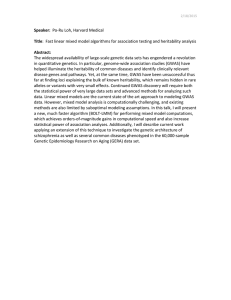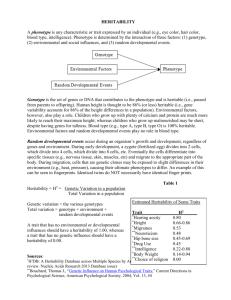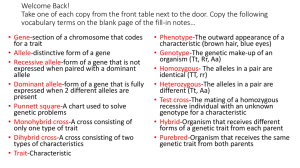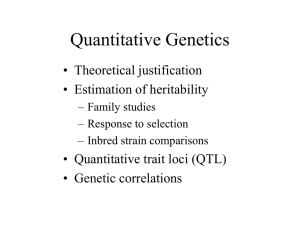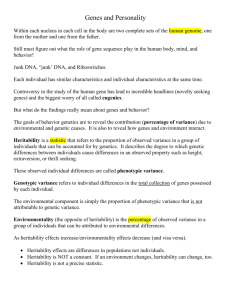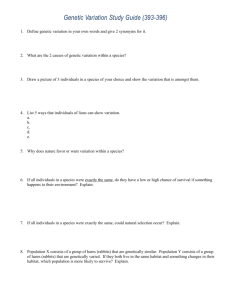Document 13111888
advertisement
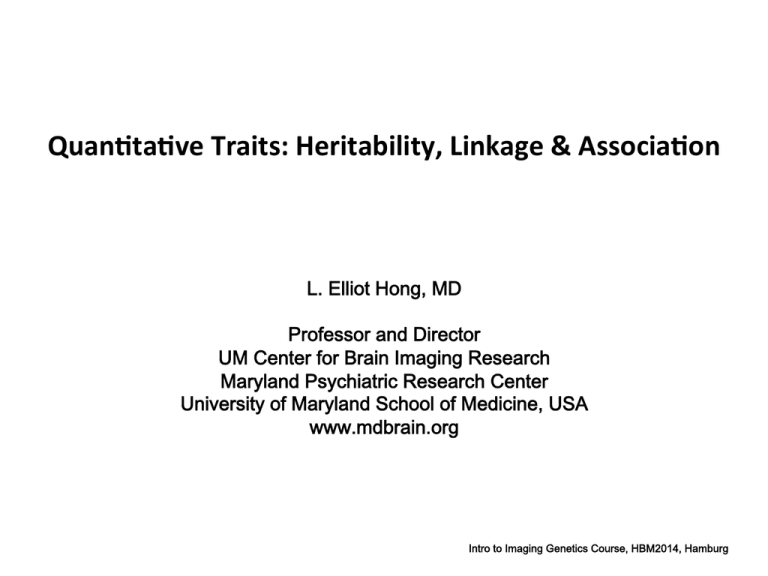
Quan%ta%ve Traits: Heritability, Linkage & Associa%on L. Elliot Hong, MD Professor and Director UM Center for Brain Imaging Research Maryland Psychiatric Research Center University of Maryland School of Medicine, USA www.mdbrain.org Intro to Imaging Genetics Course, HBM2014, Hamburg Learning Objec-ves 1. Apply gene-c epidemiology concepts in quan-ta-ve brain imaging -­‐ gene-cs studies 2. Common vs. rare variant hypotheses 3. Heritability: Falconer's, ACE twin model, family based, missing heritability 4. Linkage vs. associa-on studies Basic, conceptual discussion. Will have more details on each topic covered by experts in the following lectures Three concepts used in describing complex diseases Polygenic: the disease occurs only if several genotypes are present together Multifactorial: several distinct genes (or sets of genotypes) can independently cause the trait Partially penetrant: partially or poorly penetrant; nongenetic factors may also be required, or other genes may be required Complex Trait / Disease The common disease/common variant hypothesis: q Each of the liability genes (i.e., variants) has a small effect, but by itself would not cause the trait or the illness. q Disease cases are due to liability alleles exist in the population at certain frequency. q The disease is said to be polygenic. q Genome-wide association studies (GWAS) are based on common variant hypothesis Candidate Gene Approaches (Hypothesis-­‐driven) Candidate Genes Quan-ta-ve Trait Replica-on Adopted from TA Pearson Genome-­‐Wide Associa%on (GWAS) (Discovery or Agnos%c) En-re Genome Quan-ta-ve Trait Replica-on Adopted from TA Pearson Association study to identify candidate loci Controls sequence A1 20% Schizophrenics 20% sequence A1 Locus A Chomosome 12 sequence A2 no association to schizophrenia sequence A2 80% 80% 40% 70% Locus B Chomosome 8 sequence B1 sequence B1 may be near a gene that helps to cause schizophrenia sequence B2 sequence B2 60% 30% 9 Complex Trait / Disease The common disease/common variant hypothesis: q GWAS is to repeat the association study many times across the genome. q Variants in GWAS were selected based on common variants in the population (about 5% minor allele frequency) q With the newest chips of 4.8 million SNPs: about 1% MAF q Imputation can increase the coverage further q GWAS is based on the assumption that common genetic variation plays a sizable role in the heritable variations of common disease Study Designs for Associa-on Analysis • Family-­‐Based – Parent-­‐child Trio – Discordant sibpairs • Advantages – Uses the non-­‐transmiVed alleles as the control (trio) • Disadvantages – Ascertainment & Power • Case-­‐Control • Advantages – Ascertainment & Power • Disadvantages – Sensi-vity to assump-ons – Matching q With few exceptions, most brain-related traits are assumed to be from multiple genetic factors working in aggregate q The debate is on the frequency of the gene variants Complex Trait / Disease The common disease/rare variant hypothesis: q Rare in the population, but each of the liability genes or variants can be highly penetrant, or have a large effect. q Allelic heterogeneity: each disease-causing gene has many rare variations that disrupt that gene in about the same way q Disease cases are due to liability alleles at very low frequencies, detectable by sequencing. q The disease is said to be multifactorial and polygenic. Schork et al 2009 Curr Opin Genet Dev Complex Trait / Disease II The common disease/rare variant hypothesis: q Where do the rare variants come from? - Old. Being selected against, or - New. Not enough time to spread q Examples: Breast cancer genes BRCA1 and BRCA2. Hundreds of rare, disease-causing mutations have been identified. q Motivation for sequencing rather than GWAS 2 Heritability (h ) From Alan R. Rogers, University of Utah How to find the genetic basis of quantitative imaging variation? BROAD-SENSE HERITABILITY (H2) The proportion of a trait’s variation that is due to genetics. The rest of it due to “environmental” factors. VP = VG phenotypic variance genetic variance + VE environmental variance H2 = VG / VP Twin based heritability Falconer's formula This is the broad sense heritability. rmz is the monozygotic (MZ) identical twin correlation rdz is the dizygotic (DZ) fraternal twin correlation Heritability Estimate Heritability = 2(rmz – rdz) Heritability of Brain Volume = 2(.90 - .45) = .90 Thompson et al 2001 Nat Neuroscience Twin based heritability The ACE model: 1. Assumption: shared environment is MZ = DZ. 2. Caveat: If there are differences in the shared environment due to in-utero or early development effects (likely MZ > DZ), then the ACE model will over-estimate h2. 3. Many additional steps are taken to minimize or eliminate this bias Additive vs. Dominance Genetic Variance q H2 is problematic because all genetic factor is represented by Vg. q Genetic variances includes Vg = Va + Vd q Va: trait variance due to the effects of each allele adding together q Vd: variance due to interactions between alleles They can be: 1) Interaction of alleles of the same gene 2) Epistasis: interaction of the alleles between difference genes Additive vs. Dominance Genetic Variance continues…. q Vd is not directly inherited from parent to offspring. It is due to the interaction of genes from both parents q The end results: when interaction is not accounted for, there is a risk of inaccurate estimate How to find the genetic basis of quantitative imaging variation? NARROW-SENSE HERITABILITY (h2) Only additive genetic variance is used VP phenotypic variance = VA genetic variance + VD dominance genetic variance h2 = VA / VP + VE environmental variance Heritability = 0 ≠ Not genetic Every living adult has a brain. The h2 of having a brain is ?? If 100% genetic and no variance, then no heritability to calculate, according to current genetic epidemiology Twin based heritability - Issues Potentially problematic assumptions, chiefly among them: 1. The environments of identical twins = the environments of nonidentical twins. But possibly mz > dz 2. Genetic risks are combined together in a simple way. But possible there are interactions. 3. Ascertainment bias: Co-twin with disease is more likely to participate in twin studies as compared to unaffected co-twin. Twin based heritability – may not be that bad Across a wide variety of traits rmz – 2 * (rdz) = 0. Consistent with predominantly additive genetic variance and the absence of a large bias from common environmental effects Hill et al 2008 Plos Genetics Family Based Heritability (h2) Variance components VP Phenotypic variance = Va Additive genetic variance + Vc Common environmental variance + Vu Unique environmental variance h2 = VA / VP + Xi Covariates Gene%c vs. Environmental Correla%ons in Families -­‐-­‐ Informa%on for Family Based Heritability (h2) Environmental Correla-on Gene-c Rela-onship Correla-on Children Adult Family Parent-­‐child 0.5 0 0 1 Sib-­‐sib 0.5 1 0 1 Spouse-­‐Spouse 0 0 1 1 Half-­‐sibs, parernal 0.25 0 0 0 Half-­‐sibs, maternal 0.25 1 0 1 Cousins 0.125 0 0 0 Linkage Analysis • Traces the segrega-on of the trait through a family • Traces the segrega-on of the chromosomes through a family • Sta-s-cally measures the correla-on of the segrega-on of the trait with the segrega-on of the chromosome Study Designs Linkage vs. Associa-on Large Families Linkage Analysis Small Families Shared within families Association Studies Family-Based Shared across families Case-Control Adapted from Jonathan L. Haines Ph.D. Association vs. Linkage Association l l l Population based candidate gene search and verification easier to perform Linkage l l l l Family-based Mono- or oligogenic disorders Mendelian inheritance Position identification Missing Heritability q Heritability of common traits and major disorders are in the range of 50% to 90% q GWAS reveal small variances of these traits are explained genetic variants (from 0.01% to 1-2% for single SNP, to 10-30% in comprehensively studied cases) q The resting the heritability is ‘missing’ Zuk et al 2011 PNAS Zuk et al 2013 PNAS Missing Heritability – possible hiding places q More common variants are there to be discovered q Rare variants not shared by individuals – the ‘missing heritability’ may come from rare variants q ‘Over-estimated h2’ due to interactions – recall how twin based h2 is calculated. q Gene x gene or gene x environment interactions Zuk et al 2011 PNAS Zuk et al 2013 PNAS The Gene%c Origin of Neuroimaging Quan%ta%ve Trait Gene Variant Gene Expression (mRNA) Altered Physiology (Imaging Trait) Phenotype (Disease) Protein, miRNA… Adopted from TA Pearson
